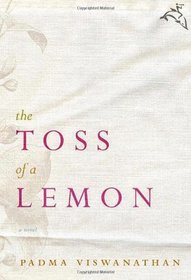Helpful Score: 2
This was a multi-generational look at life as part of the Brahmin caste in India between 1890 and about 1950. The story itself was interesting and I really appreciated learning more about the case sytem in India, how it works(ed)? and the movement to do away with it. It was a bit slow going at times because so many of the words were unfamiliar to me. But I would recommend it for anyone interested in learning about some of the traditions that have shaped India.
I must open this review with a simple but exclamatory "WOW!" What a story! Padma Viswanathan is a new author that has created such a wonderful, educational and eloquent fictional tale that has basis in her own family's stories. I learned quite a bit about the Indian Caste system (which I had always been curious about) and some of their customs and beliefs.
Based on the period of 1896- 1960s, the story carries the reader through the child bride, Sivakami, marrying the older Hanumarathnam. Hanumaranthnam is the local astrologist. They have 2 children, Vairum and Thangam. Shortly after Vairum is born, Hanumaranthnam dies. Sivakami is now a widow as a teen. This book explores the difficulties of being a widow so young. These customs could be judged by the Western world to be harsh and unfair to widows.
Thangam produces many children who are cared for by Sivakami and Vairum because her husband is never supportive or around enough. Vairum marries a musical genius, Vani, and creates a modern and high-class life for himself and his wife. I do not want to give too much of the story away for other readers so they can discover it themselves.
The tale details the complexities of the Brahmin caste and culture - insights into strict customs, superstitious beliefs and follows the transformation of a new generation of Brahmins that no longer feel tied to the old ways.
Although this book is a little over 600 pages, it never felt like it. I would have liked to have read it in 1 sitting, but didn't have the time. Instead it took me approximately a month to read it in small sections. But any time I had free, I spent reading the book. I couldn't wait to see what would happen next.
I will look for future works written by this author. I highly recommend it to anyone who wants a good, long tale or that is interested in learning more about the caste system and Indian cultures/customs.
Give it a try. I doubt that anyone, or most readers, would be disappointed.
Based on the period of 1896- 1960s, the story carries the reader through the child bride, Sivakami, marrying the older Hanumarathnam. Hanumaranthnam is the local astrologist. They have 2 children, Vairum and Thangam. Shortly after Vairum is born, Hanumaranthnam dies. Sivakami is now a widow as a teen. This book explores the difficulties of being a widow so young. These customs could be judged by the Western world to be harsh and unfair to widows.
Thangam produces many children who are cared for by Sivakami and Vairum because her husband is never supportive or around enough. Vairum marries a musical genius, Vani, and creates a modern and high-class life for himself and his wife. I do not want to give too much of the story away for other readers so they can discover it themselves.
The tale details the complexities of the Brahmin caste and culture - insights into strict customs, superstitious beliefs and follows the transformation of a new generation of Brahmins that no longer feel tied to the old ways.
Although this book is a little over 600 pages, it never felt like it. I would have liked to have read it in 1 sitting, but didn't have the time. Instead it took me approximately a month to read it in small sections. But any time I had free, I spent reading the book. I couldn't wait to see what would happen next.
I will look for future works written by this author. I highly recommend it to anyone who wants a good, long tale or that is interested in learning more about the caste system and Indian cultures/customs.
Give it a try. I doubt that anyone, or most readers, would be disappointed.




